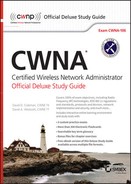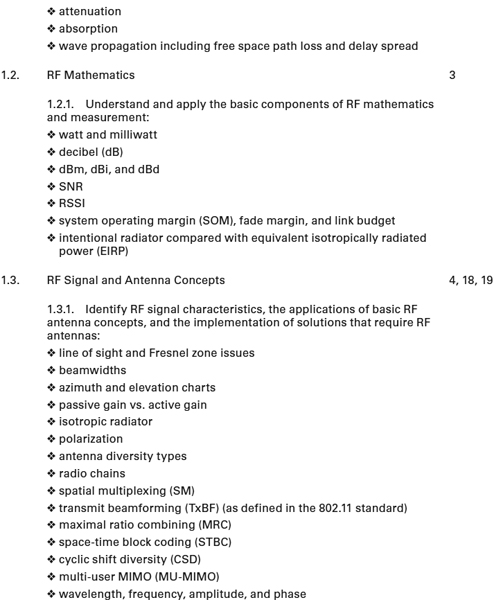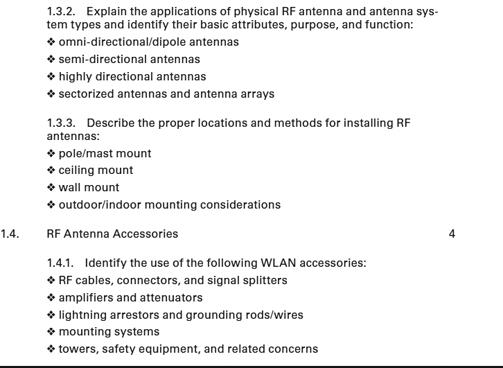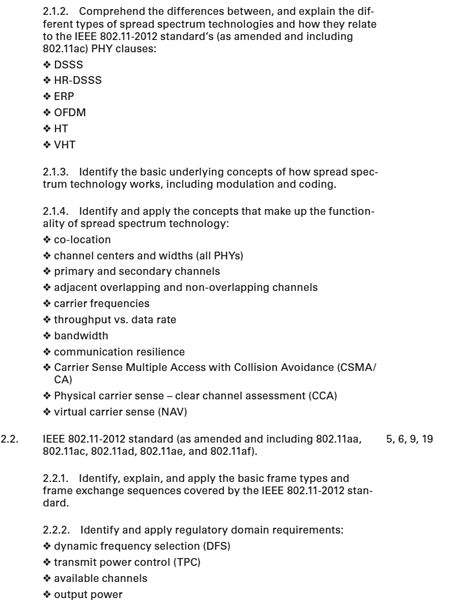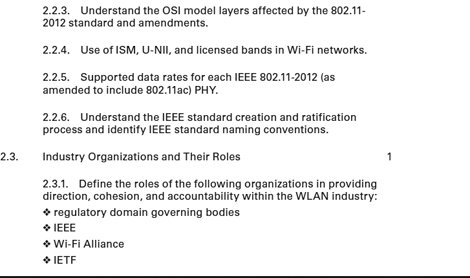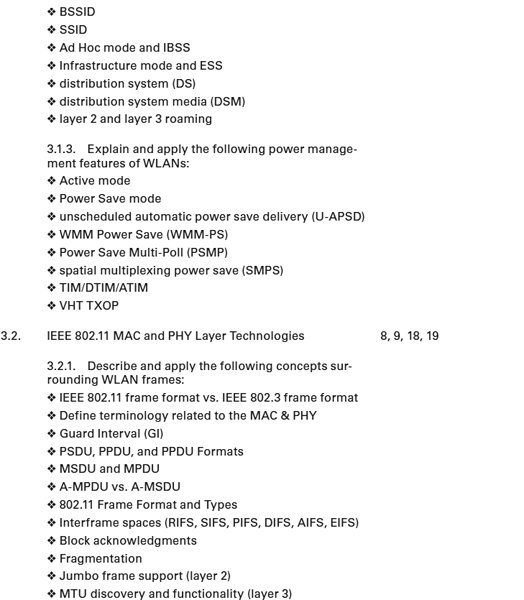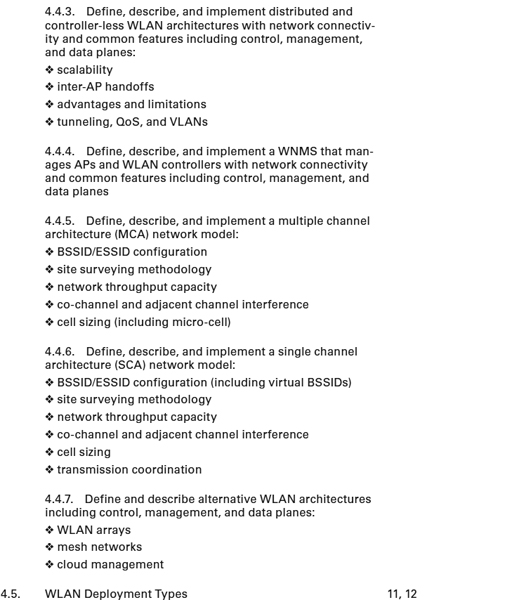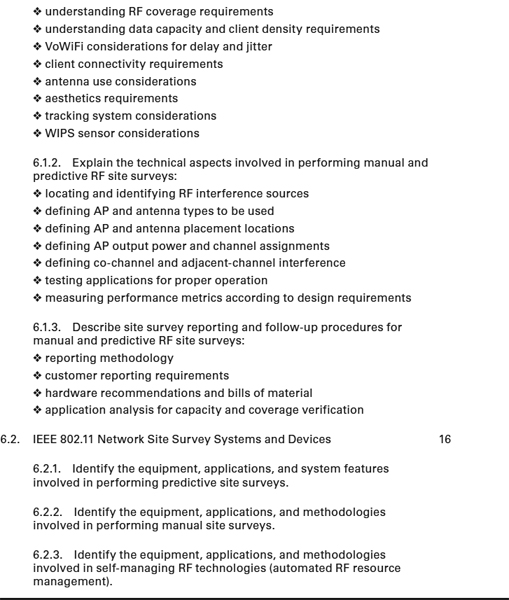Introduction
If you have purchased this book or if you are thinking about purchasing this book, you probably have some interest in taking the CWNA® (Certified Wireless Network Administrator) certification exam or in learning more about what the CWNA certification exam encompasses. We would like to congratulate you on this first step, and we hope that our book can help you on your journey. Wireless networking is one of the hottest technologies on the market. As with many fast-growing technologies, the demand for knowledgeable people is often greater than the supply. The CWNA certification is one way to prove that you have the knowledge and skills to support this growing industry. This Study Guide was written with that goal in mind.
This book was written to help teach you about wireless networking so that you have the knowledge needed not only to pass the CWNA certification test but also to be able to design, install, and support wireless networks. We have included review questions at the end of each chapter to help you test your knowledge and prepare for the test. We have also included labs, videos, and presentations as part of the book's interactive online learning environment and test bank (http://sybextestbanks.wiley.com) to further facilitate your learning.
Before we tell you about the certification process and requirements, we must mention that this information may have changed by the time you take your test. We recommend that you visit www.cwnp.com as you prepare to study for your test to determine what the current objectives and requirements are.
 Do not just study the questions and answers! The practice questions in this book are designed to test your knowledge of a concept or objective that is likely to be on the CWNA exam. The practice questions will be different from the actual certification exam questions. If you learn and understand the topics and objectives, you will be better prepared for the test.
Do not just study the questions and answers! The practice questions in this book are designed to test your knowledge of a concept or objective that is likely to be on the CWNA exam. The practice questions will be different from the actual certification exam questions. If you learn and understand the topics and objectives, you will be better prepared for the test.
About CWNA® and CWNP®
If you have ever prepared to take a certification test for a technology that you are unfamiliar with, you know that you are not only studying to learn a different technology but probably also learning about an industry that you are unfamiliar with. Read on and we will tell you about CWNP.
CWNP is an abbreviation for Certified Wireless Network Professional. There is no CWNP test. The CWNP program develops courseware and certification exams for wireless LAN technologies in the computer networking industry. The CWNP certification program is a vendor-neutral program.
The objective of CWNP is to certify people on wireless networking, not on a specific vendor's product. Yes, at times the authors of this book and the creators of the certification will talk about, demonstrate, or even teach how to use a specific product; however, the goal is the overall understanding of wireless, not the product itself. If you learned to drive a car, you had to physically sit and practice in one. When you think back and reminisce, you probably do not tell someone you learned to drive a Ford; you probably say you learned to drive using a Ford.
There are seven wireless certifications offered by the CWNP program:
CWTS: Certified Wireless Technology Specialist CWTS is an entry-level WLAN certification exam (PW0-071). This certification is geared specifically toward both WLAN sales and support staff for the enterprise WLAN industry. The CWTS certification verifies that sales and support staff are specialists in WLAN technology and have all the fundamental knowledge, tools, and terminology to more effectively sell and support WLAN technologies.
CWNA: Certified Wireless Network Administrator The CWNA certification is a foundation-level Wi-Fi certification; however, it is not considered an entry-level technology certification. Individuals taking this exam (CWNA 106) typically have a solid grasp on network basics such as the OSI model, IP addressing, PC hardware, and network operating systems. Many candidates already hold other industry-recognized certifications, such as the CompTIA Network+ or Cisco CCNA, and are looking for the CWNA certification to enhance or complement existing skills.
CWSP: Certified Wireless Security Professional The CWSP certification exam (PW0-204) is focused on standards-based wireless security protocols, security policy, and secure wireless network design. This certification introduces candidates to many of the technologies and techniques that intruders use to compromise wireless networks and that administrators use to protect wireless networks. With recent advances in wireless security, WLANs can be secured beyond their wired counterparts.
CWDP: Certified Wireless Design Professional The CWDP certification exam (PW0-250) is a professional-level career certification for networkers who are already CWNA certified and have a thorough understanding of RF technologies and applications of 802.11 networks. This certification prepares WLAN professionals to properly design wireless LANs for different applications to perform optimally in different environments.
CWAP: Certified Wireless Analysis Professional The CWAP certification exam (PW0-270) is a professional-level career certification for networkers who are already CWNA certified and have a thorough understanding of RF technologies and applications of 802.11 networks. This certification provides an in-depth look at 802.11 operations and prepares WLAN professionals to be able to perform, interpret, and understand wireless packet and spectrum analysis.
CWNE: Certified Wireless Network Expert The CWNE certification is the highest-level certification in the CWNP program. By successfully completing the CWNE requirements, you will have demonstrated that you have the most advanced skills available in today's wireless LAN market. The CWNE certification requires CWNA, CWAP, CWDP, and CWAP certifications. To earn the CWNE certification, a rigorous application must be submitted and approved by CWNP's review team.
CWNT: Certified Wireless Network Trainer Certified Wireless Network Trainers are qualified instructors certified by the CWNP program to deliver CWNP training courses to IT professionals. CWNTs are technical and instructional experts in wireless technologies, products, and solutions. To ensure a superior learning experience for our customers, CWNP Education Partners are required to use CWNTs when delivering training using official CWNP courseware. More information about becoming a CWNT is available on the CWNP website.
How to Become a CWNA
To become a CWNA, you must do the following two things: agree that you have read and will abide by the terms and conditions of the CWNP Confidentiality Agreement and pass the CWNA certification test.
 A copy of the CWNP Confidentiality Agreement can be found online at the CWNP website.
A copy of the CWNP Confidentiality Agreement can be found online at the CWNP website.
When you sit to take the test, you will be required to accept this confidentiality agreement before you can continue with the test. After you have agreed, you will be able to continue with the test, and if you pass it, you are then a CWNA.
The information for the exam is as follows:
Exam name: Wireless LAN Administrator
Exam number: CWNA 106
Cost: $175 (in US dollars)
Duration: 90 minutes
Questions: 60
Passing score: 70 percent (80 percent for instructors)
Available languages: English
Availability: Register at Pearson VUE (www.vue.com/cwnp)
When you schedule the exam, you will receive instructions regarding appointment and cancellation procedures, ID requirements, and information about the testing center location. In addition, you will receive a registration and payment confirmation letter. Exams can be scheduled weeks in advance or, in some cases, even as late as the same day. Exam vouchers can also be purchased at the CWNP website.
After you have successfully passed the CWNA exam, the CWNP program will award you a certification that is good for three years. To recertify, you will need to pass the current CWNA exam, the CWSP exam, the CWDP exam, or the CWAP exam that is current at that time. If the information you provided to the testing center is correct, you will receive an email from CWNP recognizing your accomplishment and providing you with a CWNP certification number. After you earn any CWNP certification, you can request a certification kit. The kit includes a congratulatory letter, a certificate, and a wallet-sized personalized ID card. You will need to log in to the CWNP tracking system, verify your contact information, and request your certification kit.
Who Should Buy This Book?
If you want to acquire a solid foundation in wireless networking and your goal is to prepare for the exam, this book is for you. You will find clear explanations of the concepts you need to grasp and plenty of help to achieve the high level of professional competency you need in order to succeed.
If you want to become certified as a CWNA, this book is definitely what you need. However, if you just want to attempt to pass the exam without really understanding wireless, this Study Guide is not for you. It is written for people who want to acquire hands-on skills and in-depth knowledge of wireless networking.
Interactive Online Learning Environment and Test Bank
The interactive online learning environment that accompanies CWNA Certified Wireless Network Administrator Official Deluxe Study Guide: Exam CWNA-106 provides a test bank with many study tools to help you prepare for the certification exam—and increase your chances of passing it the first time! The test bank includes:
Sample Tests All of the questions in this book are provided, including the Assessment Test, which you'll find at the end of this introduction, and the Chapter Tests that include the Review Questions at the end of each chapter. In addition, there are three Practice Exams. Use these questions to test your knowledge of the study guide material. The online test bank runs on multiple devices.
Flashcards Questions are provided in digital flashcard format (a question followed by a single correct answer). You can use the flashcards to reinforce your learning and provide last-minute test prep before the exam.
Other Study Tools Several bonus study tools are included:
Glossary The key terms from this book and their definitions are available as a fully searchable PDF.
Bonus Materials There are additional materials for Chapters 2, 3, 4, 9, 13, and 15. Use these materials to assist you in learning concepts and completing the exercises.
eBook in three formats Many of you are always on the go, and lugging around a copy of a printed book is sometimes not always practical, so the eBook is included in Mobi, ePDF, and ePub formats. Now, you can read the book on your computer, laptop, or your favorite e-reader or tablet.
 Go to http://sybextestbanks.wiley.com to register and gain access to this interactive online learning environment and test bank with study tools.
Go to http://sybextestbanks.wiley.com to register and gain access to this interactive online learning environment and test bank with study tools.
How to Use This Book and Test Bank
We have included several testing features in the book and on the book's interactive online learning environment and test bank (http://sybextestbanks.wiley.com). These tools will help you retain vital exam content as well as prepare you to sit for the actual exam.
This book has a number of features designed to guide your study efforts for the CWNA certification exam. All of these features are intended to assist you in doing the most important thing you can do to pass the exam: understand and apply the test specs in answering questions. This book helps you do that by listing the current test specs at the beginning of each chapter and by ensuring that each of them is fully discussed in the chapter.
The review questions at the end of each chapter and the practice exams included with the online test bank (which can be found at http://sybextestbanks.wiley.com) are designed to assist you in testing your retention of the material you've read to make you aware of areas on which you should spend additional study time. We've provided web links and other resources to assist you in mastering areas where you may require additional study materials. Here are some suggestions for using this book and study tools:
Before You Begin At the beginning of the book (right after this introduction) is an assessment test that you can use to check your readiness for the exam. Take this test before you start reading the book; it will help you determine the areas that you may need to brush up on. The answers to the assessment test appear on a separate page after the last question of the test. Each answer includes an explanation and a note telling you the chapter in which the material appears.
Objective Map and Opening List of Objectives A detailed exam-objective map shows you where each of the exam objectives is covered in this book. In addition, each chapter opens with a list of exam objectives that are covered in that chapter. Use these to see exactly where each of the exam topics is covered.
Summary The summary is a brief review of the chapter to sum up what was covered.
Exam Essentials The Exam Essentials section at the end of each chapter highlights topics that could appear on one or both of the exams in some form. Although we obviously don't know exactly what will be included in a particular exam, these sections reinforce significant concepts that are key to understanding the functional area and the test specs HRCI has developed.
Chapter Review Questions To test your knowledge as you progress through the book, there are review questions at the end of each chapter. As you finish each chapter, answer the review questions and then check your answers. You can go back and reread the section that deals with each question you answered incorrectly to ensure that you answer correctly the next time you are tested on the material.
Flashcards You will find flashcards at http://sybextestbanks.wiley.com. These are short questions and answers, just like the flashcards you probably used in school. Review them on your devices for quick and convenient study.
Practice Exams In addition to the assessment test and the chapter review questions, you will find three Practice Exams. Take these practice exams just as if you were taking the actual exam (without any reference material). When you have finished the first exam, move on to the next one to solidify your test-taking skills. If you answer more than 95 percent of the questions correctly, you are ready to take the certification exam.
Labs and Exercises Several chapters in this book include labs that use software, spreadsheets, and videos that are also provided (http://sybextestbanks.wiley.com). These labs and exercises will provide you with a broader learning experience by supplying hands-on experience and step-by-step problem solving.
White Papers Several chapters in this book reference wireless networking white papers that are available from the referenced websites. These white papers serve as additional reference material for preparing for the CWNA exam.
CWNA Exam (CWNA-106) Objectives
The CWNA exam measures your understanding of the fundamentals of RF behavior, your ability to describe the features and functions of wireless LAN components, and your knowledge of the skills needed to install, configure, and troubleshoot wireless LAN hardware peripherals and protocols.
The skills and knowledge measured by this exam were derived from a survey of wireless networking experts and professionals. The results of this survey were used in weighing the subject areas and ensuring that the weighting is representative of the relative importance of the content.
The following chart provides the breakdown of the exam, showing you the weight of each section:
Radio Frequency (RF) Technologies–21%
1.1. RF Fundamentals
1.1.1. Define and explain the basic concepts of RF behavior.
- Gain and loss
- Reflection, refraction, diffraction, and scattering
- VSWR
- Return loss
- Amplification
- Attenuation
- Absorption
- Wave propagation including free space path loss (FSPL) and delay spread
1.2. RF Mathematics
1.2.1. Understand and apply the basic components of RF mathematics and measurement.
- Watt and milliwatt
- Decibel (dB)
- dBm, dBi and dBd
- SNR
- RSSI
- System operating margin (SOM), fade margin and link budget
- Intentional radiator compared with equivalent isotropically radiated power (EIRP)
1.3. RF Signal and Antenna Concepts
1.3.1. Identify RF signal characteristics, the applications of basic RF antenna concepts, and the implementation of solutions that require RF antennas.
- Line of sight and Fresnel zone issues
- Beamwidths
- Azimuth and elevation charts
- Passive gain vs. active gain
- Isotropic radiator
- Polarization
- Antenna diversity types
- Radio chains
- Spatial multiplexing (SM)
- Transmit beamforming (TxBF) (as defined by the 802.11 standard)
- Maximal ratio combining (MRC)
- Space-time block coding (STBC)
- Cyclic shift diversity (CSD)
- Multi-user MIMO (MU-MIMO)
- Wavelength, frequency, amplitude, and phase
1.3.2. Explain the applications of physical RF antenna and antenna system types and identify their basic attributes, purpose, and function.
- Omni-directional/dipole antennas
- Semi-directional antennas
- Highly directional antennas
- Sectorized antennas and antenna arrays
1.3.3. Describe the proper locations and methods for installing RF antennas.
- Pole/mast mount
- Ceiling mount
- Wall mount
- Outdoor/indoor mounting considerations
1.4. RF Antenna Accessories
1.4.1. Identify the use of the following WLAN accessories.
- RF cables, connectors, and signal splitters
- Amplifiers and attenuators
- Lightning arrestors and grounding rods/wires
- Mounting systems
- Towers, safety equipment, and related concerns
IEEE 802.11 Regulations and Standards–17%
2.1. Spread Spectrum Technologies
2.1.1. Identify some of the uses for wireless networking technologies.
2.1.2. Comprehend the differences between, and explain the different types of, spread spectrum technologies and how they relate to the IEEE 802.11-2012 standard's (as amended and including IEEE 802.11ac) PHY clauses.
- DSSS
- HR-DSSS
- ERP
- OFDM
- HT
- VHT
2.1.3. Identify the basic underlying concepts of how spread spectrum technology works.
- Modulation
- Coding
2.1.4. Identify and apply the concepts that make up the functionality of spread spectrum technology.
- Co-location
- Channel centers and widths (all PHYs)
- Primary and secondary channels
- Adjacent overlapping and nonoverlapping channels
- Carrier frequencies
- Throughput vs. data rate
- Bandwidth
- Communication resilience
- Carrier Sense Multiple Access with Collision Avoidance (CSMA/CA)
- Physical carrier sense – clear channel assessment (CCA)
- Virtual carrier sense (NAV)
2.2. IEEE 802.11-2012 Standard (as amended and including 802.11aa, 802.11ac, 802.11ad, 802.11ae, and 802.11af)
2.2.1. Identify, explain, and apply the frame types and frame exchange sequences covered by the IEEE 802.11-2012 standard.
2.2.2. Identify and apply regulatory domain requirements.
2.2.3. Understand the OSI model layers affected by the 802.11-2012 standard and amendments.
2.2.4. Use of ISM, U-NII and licensed bands in Wi-Fi networks.
2.2.5. Supported data rates for each IEEE 802.11-2012 (as amended to include 802.11ac) PHY.
2.2.6. Understand the IEEE standard creation and ratification process and identify IEEE standard naming conventions.
2.3. 802.11 Industry Organizations and Their Roles
2.3.1. Define the roles of the following organizations in providing direction, cohesion, and accountability within the WLAN industry.
- Regulatory domain governing bodies
- IEEE
- Wi-Fi Alliance
- IETF
IEEE 802.11 Protocols and Devices–17%
3.1. IEEE 802.11 Protocol Architecture
3.1.1. Summarize the processes involved in authentication and association.
- The 802.11 state machine
- Open System authentication, Shared Key authentication, and deauthentication
- Association, reassociation, and disassociation
3.1.2. Define, describe, and apply the following concepts associated with WLAN service sets.
- Stations
- BSSs
- Basic service area (BSA)
- Starting and joining a BSS
- BSSID
- SSID
- Ad Hoc mode and IBSS
- Infrastructure mode and ESS
- Distribution system (DS)
- Distribution system medium (DSM)
- Layer 2 and layer 3 roaming
3.1.3. Explain and apply the following power-management features of WLANs.
- Active mode
- Power Save mode
- Unscheduled automatic power save delivery (U-APSD)
- WMM Power Save (WMM-PS)
- Power Save Multi-Poll (PSMP)
- Spatial multiplexing power save (SMPS)
- TIM/DTIM/ATIM
- VHT TXOP
3.2. IEEE 802.11 MAC and PHY Layer Technologies
3.2.1. Describe and apply the following concepts surrounding WLAN frames.
- IEEE 802.11 frame format vs. IEEE 802.3 frame format
- Define terminology related to the MAC and PHY
- Guard interval (GI)
- PSDU, PPDU, and PPDU formats
- MSDU, MPDU
- A-MPDU vs. A-MSDU
- 802.11 frame format and types
- Interframe spaces (RIFS, SIFS, PIFS, DIFS, AIFS, EIFS)
- Block acknowledgments
- Fragmentation
- Jumbo frame support (layer 2)
- MTU discovery and functionality (layer 3)
3.2.2. Identify methods described in the IEEE 802.11-2012 standard for locating, joining, and maintaining connectivity with an 802.11 WLAN.
- Active scanning (probes)
- Passive scanning (beacons)
- Dynamic rate switching (DRS)
3.2.3. Define, describe, and apply IEEE 802.11 coordination functions and channel access methods and features available for optimizing data flow across the RF medium.
- DCF and HCF coordination functions
- EDCA channel access method
- RTS/CTS and CTS-to-Self protocols
- HT channel width operation
- HT protection mechanisms
- HT operation modes (0, 1, 2, 3)
- VHT channel width operation
- VHT protection mechanisms
- VHT Operating Mode field
3.3 WLAN Infrastructure and Client Devices
3.3.1. Identify the purpose of the following WLAN infrastructure devices and describe how to install, configure, secure, and manage them.
- Autonomous access points
- Controller-based access points
- Mesh access points/routers
- Enterprise WLAN controllers
- Distributed WLAN architectures
- Remote office WLAN controllers and/or APs
- PoE injectors (single and multiport) and PoE-enabled Ethernet switches
- WLAN bridges
- Home and branch WLAN routers
3.3.2. Describe the purpose of the following WLAN client devices and explain how to install, configure, secure, and manage them.
- PC Cards (ExpressCard, CardBus, and PCMCIA)
- USB2/3
- PCI, Mini PCI, Mini PCIe, and Half Mini PCIe cards
- Workgroup bridges
IEEE 802.11 Network Implementation–25%
4.1. 802.11 Network Design, Implementation, and Management
4.1.1. Identify technology roles for which WLAN technology is appropriate and describe implementation of WLAN technology in those roles.
- Corporate data access and end-user mobility
- Network extension to remote areas
- Building-to-building connectivity (bridging)
- Last-mile data delivery—wireless ISP
- Small office/home office (SOHO) use
- Mobile office networking
- Educational/classroom use
- Industrial—warehousing and manufacturing
- Healthcare—hospitals and offices
- Hotspots—public network access
- Transportation networks (trains, planes, automobiles)
- Law enforcement networks
4.2. 802.11 Network Troubleshooting
4.2.1. Identify and explain how to solve the following WLAN implementation challenges by using features available in enterprise-class WLAN equipment.
- System throughput
- Co-channel and adjacent-channel interference
- RF noise and noise floor
- Narrowband and wideband RF interference
- Multipath (in SISO and MIMO environments)
- Hidden nodes, near/far, weather, and possible solutions
4.3 Power over Ethernet (PoE)
4.3.1. IEEE 802.3-2012, Clause 33 Powering 802.11 devices
- Proprietary midspan and endpoint PSEs
- IEEE 802.3 at midspan and endpoint PSEs
4.4. WLAN Architectures - Configuration, Installation and Management
4.4.1. Define, describe, and implement autonomous APs with network connectivity and common features including control, management and data planes
4.4.2. Define, describe, and implement WLAN controllers that use centralized and/or distributed forwarding with network connectivity and common features including control, management and data planes
- Core, distribution, and access layer forwarding
- Controller-based, mesh, and portal APs
- Scalability
- Intra- and inter-controller station handoffs
- Advantages and limitations
- Tunneling, QoS, and VLANs
4.4.3. Define, describe, and implement distributed and controller-less WLAN architectures with network connectivity and common features including control, management and data planes.
- Scalability
- Inter-AP handoffs
- Advantages and limitations
- Tunneling, QoS, and VLANs
4.4.4. Define, describe, and implement a WNMS that manages APs and WLAN controllers with network connectivity and common features including control, management, and data planes.
4.4.5. Define, describe, and implement a multiple-channel architecture (MCA) network model.
- BSSID/ESSID configuration
- Site surveying methodology
- Network throughput capacity
- Co-channel and adjacent-channel interference
- Cell sizing (including micro-cell)
4.4.6. Define, describe, and implement a single channel architecture (SCA) network model.
- BSSID/ESSID configuration (including virtual BSSIDs)
- Site surveying methodology
- Network throughput capacity
- Co-channel and adjacent-channel interference
- Cell sizing
- Transmission coordination
4.4.7. Define and describe alternative WLAN architectures including control, management, and data planes.
- WLAN arrays
- Mesh networks
- Cloud management
4.5. WLAN Deployment Types
4.5.1. Understand WLAN design and deployment considerations for commonly supported WLAN applications and devices.
- Data
- Voice
- Video
- Real-Time Location Services (RTLS)
- Mobile devices (tablets and smartphones)
- High Density
- Airtime fairness
- Band steering
4.6. WLAN Access and Deployment Technologies
- Bring your own device (BYOD)
- Guest access
- Mobile device management (MDM)
- Network access control (NAC)
IEEE 802.11 Network Security–8%
5.1. IEEE 802.11 Network Security Architecture
5.1.1. Identify and describe the strengths, weaknesses, appropriate uses, and implementation of the following IEEE 802.11 security-related items.
- Weak security mechanisms
- WEP cipher suite
- Open System authentication
- Shared Key authentication
- MAC filtering
- SSID hiding
- Effective security mechanisms
- WPA-/WPA2-Enterprise
- WPA-/WPA2-Personal
- TKIP and CCMP cipher suites
- 802.1X/EAP framework
- Preshared key (PSK)/passphrase authentication
- Per-user preshared keys (PPSK)
- Wi-Fi Protected Setup (WPS)
- Additional mechanisms
5.2. 802.11 Network Security Analysis, Performance Analysis, and Troubleshooting
5.2.1. Describe, explain, and illustrate the appropriate applications for the following wireless security solutions from a monitoring, containment, and reporting perspective.
- Wireless intrusion protection system (WIPS)
- Protocol and spectrum analyzers
IEEE 802.11 RF Site Surveying–12%
6.1. IEEE 802.11 Network Site Survey Fundamentals
6.1.1. Explain the importance of and the processes involved in information collection for manual and predictive RF site surveys.
- Gathering business requirements
- Interviewing managers and users
- Defining physical and data security requirements
- Gathering site-specific documentation
- Documenting existing network characteristics
- Gathering permits and zoning requirements
- Indoor- or outdoor-specific information
- Identifying infrastructure connectivity and power requirements
- Understanding RF coverage requirements
- Understanding data capacity and client density requirements
- VoWiFi considerations for delay and jitter
- Client connectivity requirements
- Antenna use considerations
- Aesthetics requirements
- Tracking system considerations
- WIPS sensor considerations
6.1.2. Explain the technical aspects involved in performing manual and predictive RF site surveys.
- Locating and identifying RF interference sources
- Defining AP and antenna types to be used
- Defining AP and antenna placement locations
- Defining AP output power and channel assignments
- Defining co-channel and adjacent-channel interference
- Testing applications for proper operation
- Measuring performance metrics according to design requirements
6.1.3. Describe site survey reporting and follow-up procedures for manual and predictive RF site surveys
- Reporting methodology
- Customer reporting requirements
- Hardware recommendations and bills of material
- Application analysis for capacity and coverage verification
6.2. IEEE 802.11 Network Site Survey Systems and Devices
6.2.1. Identify the equipment, applications, and system features involved in performing predictive site surveys.
6.2.2. Identify the equipment, applications, and methodologies involved in performing manual site surveys.
6.2.3. Identify the equipment, applications, and methodologies involved in self-managing RF technologies (automated RF resource management).
CWNA Exam Terminology
The CWNP program uses specific terminology when phrasing the questions on any of the CWNP exams. The terminology used most often mirrors the same language that is used by the Wi-Fi Alliance and in the IEEE 802.11-2012 standard. The most current IEEE version of the 802.11 standard is the IEEE 802.11-2012 document, which includes all the amendments that have been ratified prior to the document's publication. Standards bodies such as the IEEE often create several amendments to a standard before “rolling up” the ratified amendments (finalized or approved versions) into a new standard.
 To properly prepare for the CWNA exam, any test candidate should become 100 percent familiar with the terminology used by the CWNP program. This book defines and covers all terminology including acronyms, terms, and definitions.
To properly prepare for the CWNA exam, any test candidate should become 100 percent familiar with the terminology used by the CWNP program. This book defines and covers all terminology including acronyms, terms, and definitions.
CWNP Authorized Materials Use Policy
CWNP does not condone the use of unauthorized training materials, aka brain dumps. Individuals who utilize such materials to pass CWNP exams will have their certifications revoked. In an effort to more clearly communicate CWNP's policy on use of unauthorized study materials, CWNP directs all certification candidates to the CWNP Candidate Conduct Policy, which is available on the CWNP website. Please review this policy before beginning the study process for any CWNP exam. Candidates will be required to state that they understand and have abided by this policy at the time of exam delivery.
Tips for Taking the CWNA Exam
Here are some general tips for taking your exam successfully:
- Bring two forms of ID with you. One must be a photo ID, such as a driver's license. The other can be a major credit card or a passport. Both forms must include a signature.
- Arrive early at the exam center so you can relax and review your study materials, particularly tables and lists of exam-related information.
- Read the questions carefully.
- Do not be tempted to jump to an early conclusion. Make sure you know exactly what the question is asking.
- There will be questions with multiple correct responses.
- When there is more than one correct answer, a message at the bottom of the screen will prompt you to either “choose two” or “choose all that apply.” Be sure to read the messages displayed to know how many correct answers you must choose.
- When answering multiple-choice questions you are not sure about, use a process of elimination to get rid of the obviously incorrect answers first. Doing so will improve your odds if you need to make an educated guess.
- Do not spend too much time on one question.
- This is a form-based test; however, you cannot move backward through the exam. You must answer the current question before you can move to the next question, and after you have moved to the next question, you cannot go back and change your answer on a previous question.
- Keep track of your time.
- Because this is a 90-minute test consisting of 60 questions, you have an average of 90 seconds to answer each question. You can spend as much or as little time on any one question, but when 90 minutes is up, the test is over. Check your progress. After 45 minutes, you should have answered at least 30 questions. If you have not, do not panic. You will simply need to answer the remaining questions at a faster pace. If on average you can answer each of the remaining 30 questions 4 seconds quicker, you will recover 2 minutes. Again, do not panic; just pace yourself.
- For the latest pricing on the exams and updates to the registration procedures, visit CWNP's website at www.cwnp.com.
CWNA: Certified Wireless Network Administrator Exam (CWNA-106) Objectives Map
The CWNA Certified Wireless Network Administrator Official Deluxe Study Guide was written to cover every CWNA-106 exam objective at a level appropriate to its exam weighting. The following sections provide a breakdown of this book's exam coverage, showing you the weight of each section and listing the chapter where each objective or subobjective is covered:
| Subject area | % of exam |
| Radio frequency (RF) technologies | 21% |
| IEEE 802.11 regulations and standards | 17% |
| IEEE 802.11 protocols and devices | 17% |
| IEEE 802.11 network implementation | 25% |
| IEEE 802.11 network security | 8% |
| IEEE 802.11 RF site surveying | 12% |
| Total | 100% |
Radio Frequency (RF) Technologies

IEEE 802.11 Regulations and Standards

IEEE 802.11 Protocols and Devices
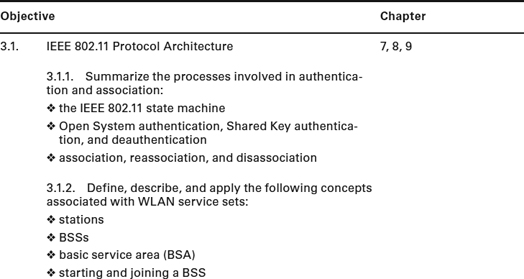
IEEE 802.11 Network Implementation
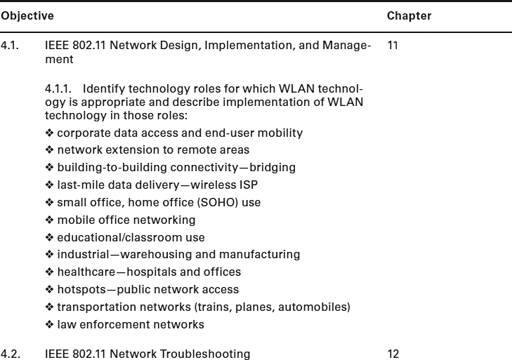
IEEE 802.11 Network Security
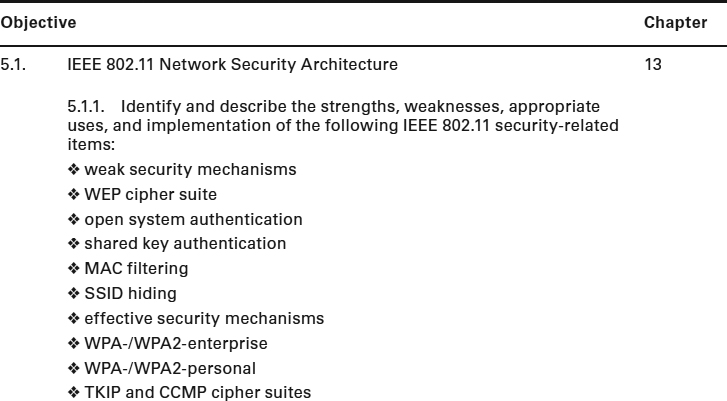
IEEE 802.11 RF Site Surveying

